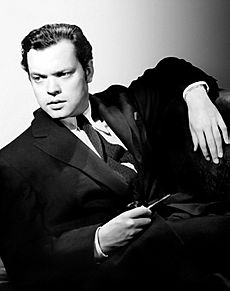Pseudo-documentary facts for kids
A pseudo-documentary is a film or video that looks like a documentary film but doesn't show real events. Instead, it uses made-up stories, actors, or situations to tell its tale. Unlike a mockumentary, a pseudo-documentary isn't always meant to be funny or to make fun of something. It might use camera styles common in documentaries but with fake sets or digital effects to create scenes that aren't real.
Contents
Films That Look Real

Orson Welles became famous for his radio show War of the Worlds. This show tricked many listeners into thinking that Martians were actually invading Earth! Film expert Jonathan Rosenbaum says this was Welles' first pseudo-documentary.
Welles later used similar ideas in his movies. For example, in his 1941 film Citizen Kane, he created a fake newsreel that looked like a real documentary. He also started his 1955 film, Mr. Arkadin, with a fake documentary-style introduction.
Peter Watkins has made several films that use the pseudo-documentary style. His 1965 film The War Game showed a fake nuclear attack on England. It was so realistic and upsetting that the BBC decided not to show it on TV. Even so, the film won an Academy Award for Best Documentary Feature. Other films by Watkins in this style include Punishment Park (1971) and La Commune (2002).
The movie Mad Max 2 also starts with a short, fake documentary-style part. This part shows images that explain to the viewer that the story takes place after a huge, worldwide war.
Fake-Fiction Films
There's a type of film that's the opposite of a pseudo-documentary, called "fake-fiction." A fake-fiction film looks like a made-up movie with actors and a script. But it actually shows real events that weren't planned or acted out.
The idea of fake-fiction was created by Pierre Bismuth to describe his 2016 film Where Is Rocky II?. This movie uses documentary methods to tell a real story. However, it's filmed and edited to look like a fiction movie. The goal is to make the real events seem as if they were made up or staged.
Unlike a mockumentary, fake-fiction isn't focused on comedy or making fun of things. Also, it's different from docufiction, which re-creates fictional versions of real past events.
Another filmmaker whose work might be called fake-fiction is Gianfranco Rosi. For example, his film Below Sea Level uses the style of fiction movies to show real, unscripted documentary material. Rosi himself said, "I don’t care if I'm making a fiction film or documentary — to me it's a film, it's a narrative thing."
Discovered Footage Films
The term "found footage" is sometimes used for pseudo-documentaries where the story is about someone finding the film's video. The original meaning of found footage is a different type of film.
However, a magazine called Variety used the term "faux found-footage film" to describe the 2012 movie Grave Encounters 2. Film expert David Bordwell doesn't like this new use because it can be confusing. He prefers the term "discovered footage" for this kind of storytelling trick.
Pseudo-Documentaries on TV
Pseudo-documentary styles have also appeared in TV commercials and political ads. The "Revolving Door" ad, used in the US presidential campaign of 1988, attacked candidate Michael Dukakis. It showed staged scenes that looked like real documentary footage of men going in and out of a prison.
The band the Del Fuegos appeared in a 1984 commercial for Miller beer. This ad used scripted scenes shot with a hand-held camera in a pseudo-documentary style. The band was criticized for doing the ad, and their main fans felt let down.
Peter Greenaway used a pseudo-documentary style in his 1988 French TV show Death on the Seine. He created fake scenes to show a historical event that couldn't be filmed in real life, and he presented it as if it were real.
Reality television has also been described as a type of pseudo-documentary. An early and very popular example is MTV's The Real World from 1992. This show was a scripted "reality" show that was almost like a soap opera.
See also
 In Spanish: Falso documental para niños
In Spanish: Falso documental para niños
- Docudrama – a play or film based on real events
- Docufiction – a mix of documentary and fiction
- Mockumentary – a funny, fake documentary

